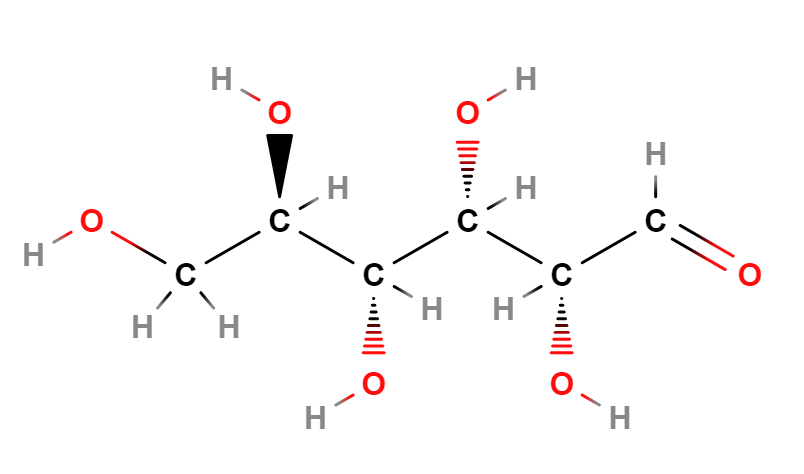| "Descrizione" by FRanier (9971 pt) | 2022-Dec-31 15:15 |
Review Consensus: 8 Rating: 8 Number of users: 1
| Evaluation | N. Experts | Evaluation | N. Experts |
|---|---|---|---|
| 1 | 6 | ||
| 2 | 7 | ||
| 3 | 8 | ||
| 4 | 9 | ||
| 5 | 10 |
Glucose (Dextrose) is a monosaccharide, polyhydroxyaldehyde, the main source of carbon for cell biosynthesis and energy generation in the human body. It is a six-carbon-atom sugar containing an aldehyde group and is the predominant monosaccharide in living organisms. Its primary function is to provide the body with energy.
Excess fat accumulation in metabolic organs, impaired glucose homeostasis and the development of insulin resistance are hallmarks of type 2 diabetes mellitus. The liver plays a key role in coordinating systemic metabolic homeostasis and adaptation to nutrient availability and deprivation (1).
Understanding the mechanisms that regulate insulin-stimulated glucose uptake by skeletal muscle is important because muscle insulin resistance is a key defect in the progression to type 2 diabetes mellitus. Even in non-diabetic individuals, insulin resistance increases the risk of atherogenesis, cardiovascular disease, hypertension, cognitive dysfunction and some cancers (2).
Glucose was used in the form of an ultrasound-guided hypertonic injection in patients with chronic shoulder pain and supra-spinous tendinopathy and was able to provide relief from pain, disability and shoulder range of motion for up to 2 weeks after surgery (3).
The aim of this study was to evaluate the efficacy of dextrose gel in the management of neonatal hypoglycaemia in postnatal wards. Conclusions: dextrose gel has been shown to be effective in the management of neonatal hypoglycaemia in the postnatal environment, reducing admission to the neonatal intensive care unit and mother-baby separation (4).
Industrially it appears as a white powder soluble in water, slightly soluble in ethanol, insoluble in ether.

What it is used for and where
Food
It is a sugar, but not as sweet-tasting as sucrose and is produced from starch by glucanase saccharification, amylase liquefaction, refining, concentration and drying processes. It is extracted with water and methanol.
Cosmetics
Glucose is used in cosmetic products as a flavouring agent, humectant, skin-conditioning agent also as D-Glucose and Dl-glucose.
Flavoring agent. The purpose of this ingredient is to modify the solution to add flavour. Natural flavouring extracts are rather expensive, so the cosmetic and pharmaceutical industries resort to synthesised substances that have sensory characteristics mostly similar to natural flavourings or are naturally equivalent. This ingredient is isolated through chemical processes or is synthesised from chemicals.
Skin conditioning agent - Humectant. Humectants are hygroscopic substances used to minimise water loss in the skin and to prevent it from drying out by facilitating faster and greater absorption of water into the stratum corneum of the epidermis. The epidermis is the most superficial of the three layers that make up the human skin (epidermis, dermis and hypodermis) and is the layer that maintains hydration in all three layers. In turn, the epidermis is composed of five layers: corneum, the most superficial, lucidum, granulosum, spinosum and basale. Humectants have the ability to retain in the stratum corneum the water they attract from the air and have the function of moisturising the skin. It is better to use them before emollients that are oil-based.
Skin conditioning agent - Miscellaneous. Ingredient that has the task of modifying the condition of the skin when it is damaged or dry by reducing its flakiness and restoring its elasticity.
Medical
Nutritional agent and used in the production of calcium gluconate and vitamin C
Other uses
- Wastewater treatment
- Microbial fermentation
- Reducing agent printing, tanning, dyeing, glass industries
- Organic crops
- Suitable for formulations such as phosphorus, molybdenum, silicon, tungsten, nitrite, etc.
- Corrosion inhibitor in closed water circulation circuits
The most relevant studies on this ingredient have been selected with a summary of the contents:
Typical commercial product characteristics Glucose
| Appearance | Crystalline powder |
| pH | 6.0~6.5 |
| Boiling Point | 527.1±50.0°C at 760 mmHg |
| Melting Point | 146°C |
| Flash Point | 286.7±26.6 °C |
| Vapor pressure | 0.0±3.1 mmHg at 25°C |
| Refraction Index | 1.573 |
| PSA | 118.22000 |
| LogP | -3.17 |
| Specific rotation | 52.0~53.5 |
| Sieve Analysis | 100% pass 80 mesh |
| Total Plate Count | 1000/g Max |
| Yeast & Mold | 100/g Max |
| Sulphate ash | ≤0.05 |
| Chloride | ≤0.01 |
| Arsenic | ≤1ppm |
| Lead | ≤2ppm |
| Cadmium | ≤1ppm |
| Hygrargyrum | ≤0.1ppm |
| Shelf life | 2 years |
 |  |
 |  |
- Molecular Formula C6H12O6
- Peso molecolare 180.156
- Exact Mass 180.063385
- CAS 50-99-7
- UNII 5SL0G7R0OK
- EC Number 200-075-1
- DSSTox Substance ID DTXSID4048729
- IUPAC (2R,3S,4R,5R)-2,3,4,5,6-pentahydroxyhexanal
- InChl=1S/C6H12O6/c7-1-3(9)5(11)6(12)4(10)2-8/h1,3-6,8-12H,2H2/t3-,4+,5+,6+/m0/s1
- InChl Key GZCGUPFRVQAUEE-SLPGGIOYSA-N
- SMILES C(C(C(C(C(C=O)O)O)O)O)O
- MDL number MFCD00063774
- PubChem Substance ID 24894295
- ChEBI 42758
- RTECS LZ6600000
- NCI C61716
- ICSC 0865
- RXCUI 349730
- Beilstein 1724615
- NACRES NA.21
Synonyms:
D-Glucose; D-(+)-Glucose: (2R,3S,4R,5R)-2,3,4,5,6-pentahydroxyhexanal, Dextrose
References__________________________________________________________________
| Evaluate |

